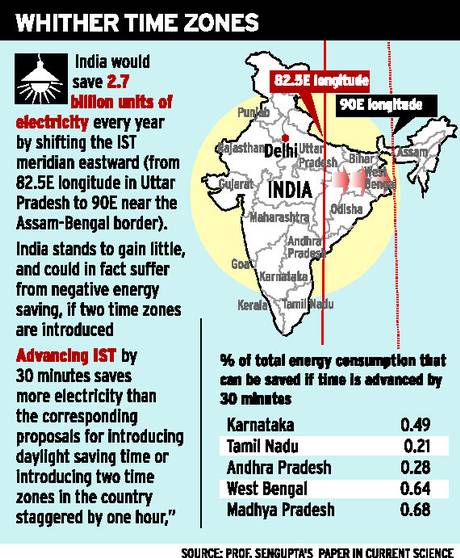Why in news?
The Gauhati High Court has dismissed a PIL seeking a direction from the Central government to notify a separate time zone for the Northeast.
What did the judgment say?
- Legislators, industrialists and others from the Northeast have often complained about the effect of IST on their lives, and pursued the issue of having a separate time zone, without much success.
- None of the other proposals such as the introduction of daylight saving time (DST) in India has met with any approval and it is felt that having two time zones would be unsuitable.
- The court cites a high-level committee study that recognised the difficulties faced by a single time zone in eastern India but concluded that IST should nonetheless be retained.
What is Daylight Saving Time?
- DST is the practice of turning the clock ahead as warmer weather approaches and back as it becomes colder again so that people will have one more hour of daylight in the afternoon and evening during the warmer season of the year.
- Less than 40% of the countries in the world use DST. Countries in equatorial and tropical climates do not observe Daylight Saving Time.
- DST usually starts in March-April and ends in September-November when the countries return to standard time.
- When Germany switched to DST on April 30, 1916 for the first time, it became the first country to use DST nationwide.
- Some studies show that DST could lead to fewer road accidents and injuries by supplying more daylight during the hours more people use the roads.
- DST is also used to reduce the amount of energy needed for artificial lighting during the evening hours.
What is the history of application of different time zones?
- A cursory history of time in India reveals that the cities of Bombay, Calcutta and Madras had their own time zones, and these were determined almost precisely by their geographical longitude.
- Bombay Time was instituted in 1905 and was maintained right up to 1955 with Bombay following its own time zone which was 38 minutes ahead of the rest of the country.
- In colonial times, there was a 1-hour 9-mins time difference between Kolkata and Mumbai. Yet, today these cities, which are 1,650km apart, share the same time.
- A few years ago, the then Assam CM, frustrated with the decision of the Centre, decided that Assam would follow ChaiBagaan time.
- Bagaan time or tea time is a reference to an informal practice followed in tea gardens in Assam which is an hour ahead of IST.
What is the basis of the demand?
- India stretches from 97.4 East in Arunachal to 68 East in Gujarat.
- The time difference between the two extreme points is approximately two hours, the effect of which is that the sun rises and sets much earlier than it does in the rest of the country.
- In the Northeast, the sun rises as early as four in the morning and in winter it sets by four in the evening.
- By the time government offices or educational institutions open, many daylight hours are already lost.
- In winter this problem gets even more accentuated and the ecological costs are a disaster with much more electricity having to be consumed.
- The National Institute of Advanced Studies claim that advancing IST by half an hour would result in saving 2.7 billion units of electricity every year.

Why their demand is getting rejected?
- Two time zones is not advisable for India as it would cause ‘unimaginable chaos’, given the country's demographic size.
- People would have to adjust to multiple time zones & administrative integration would be difficult.
- Also, India's lifeline, the railways is not yet automated enough to handle time shifts mid-journey and this could induce major accidents due to human error.
- There is also a strong political dimension to granting a separate time zone in the Northeast given the region’s long history of self-determination movements.
- The unstated assumption is that the grant of a different time zone is only the first temporal step towards conceding spatial autonomy.
Source: The Hindu
